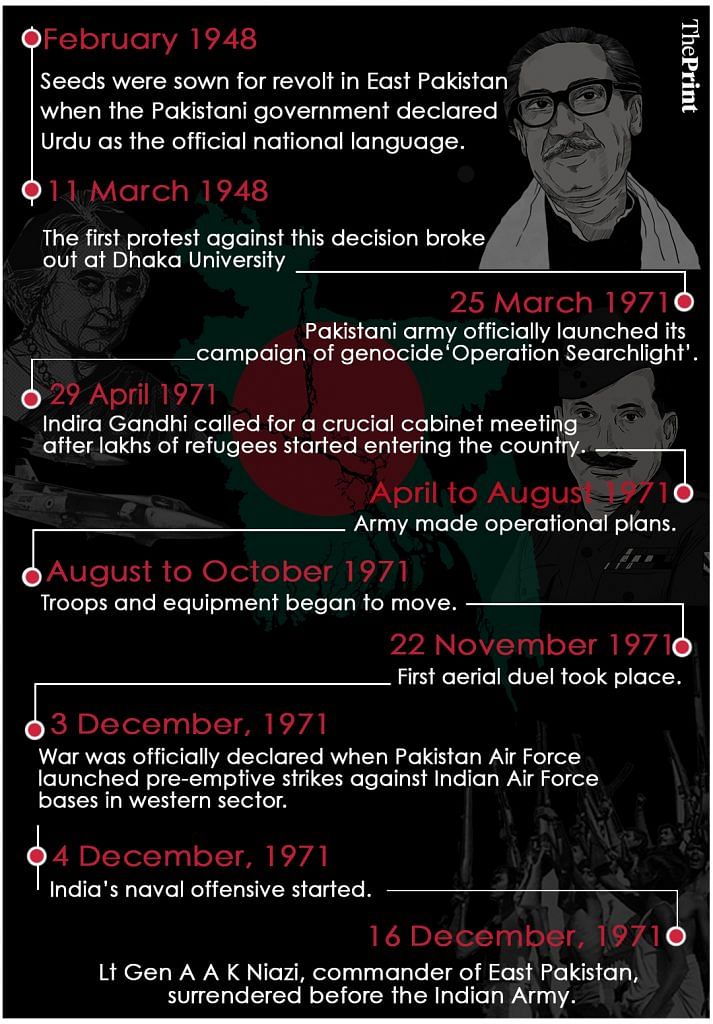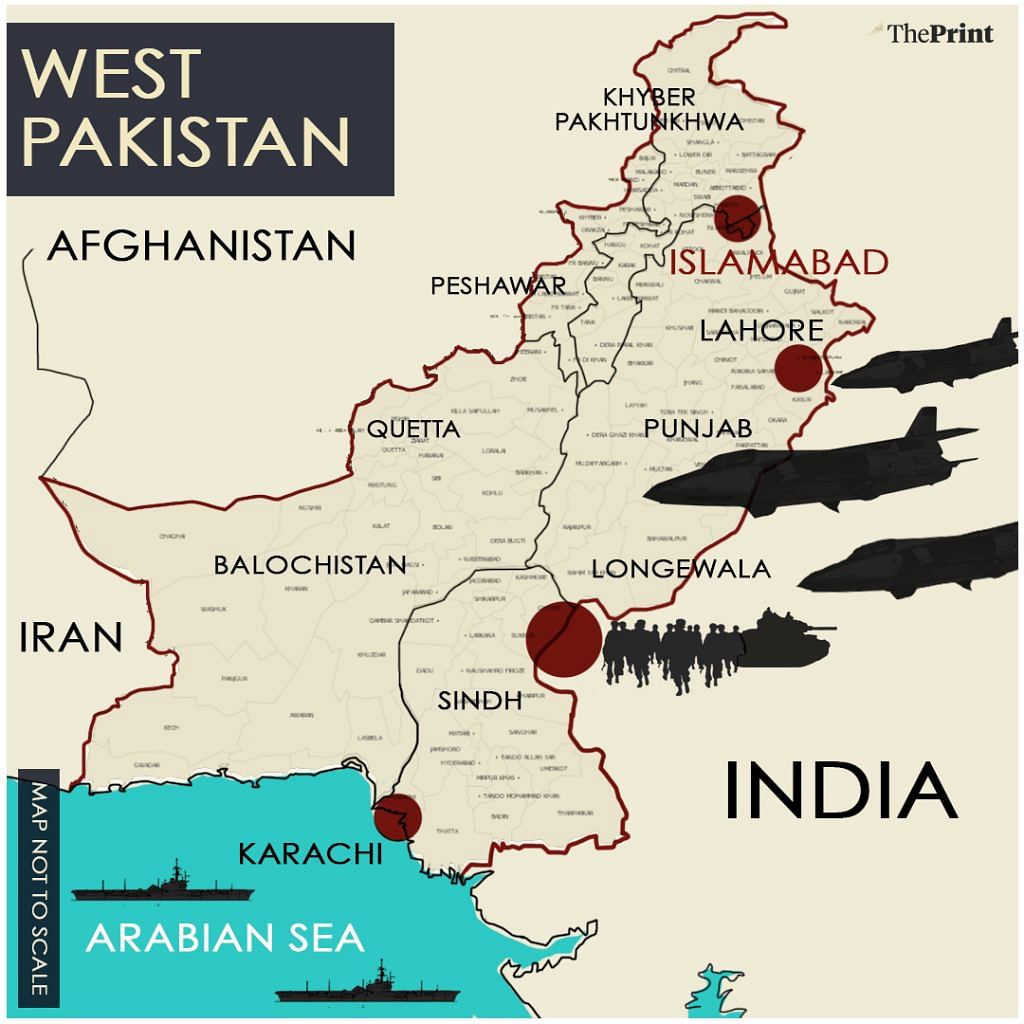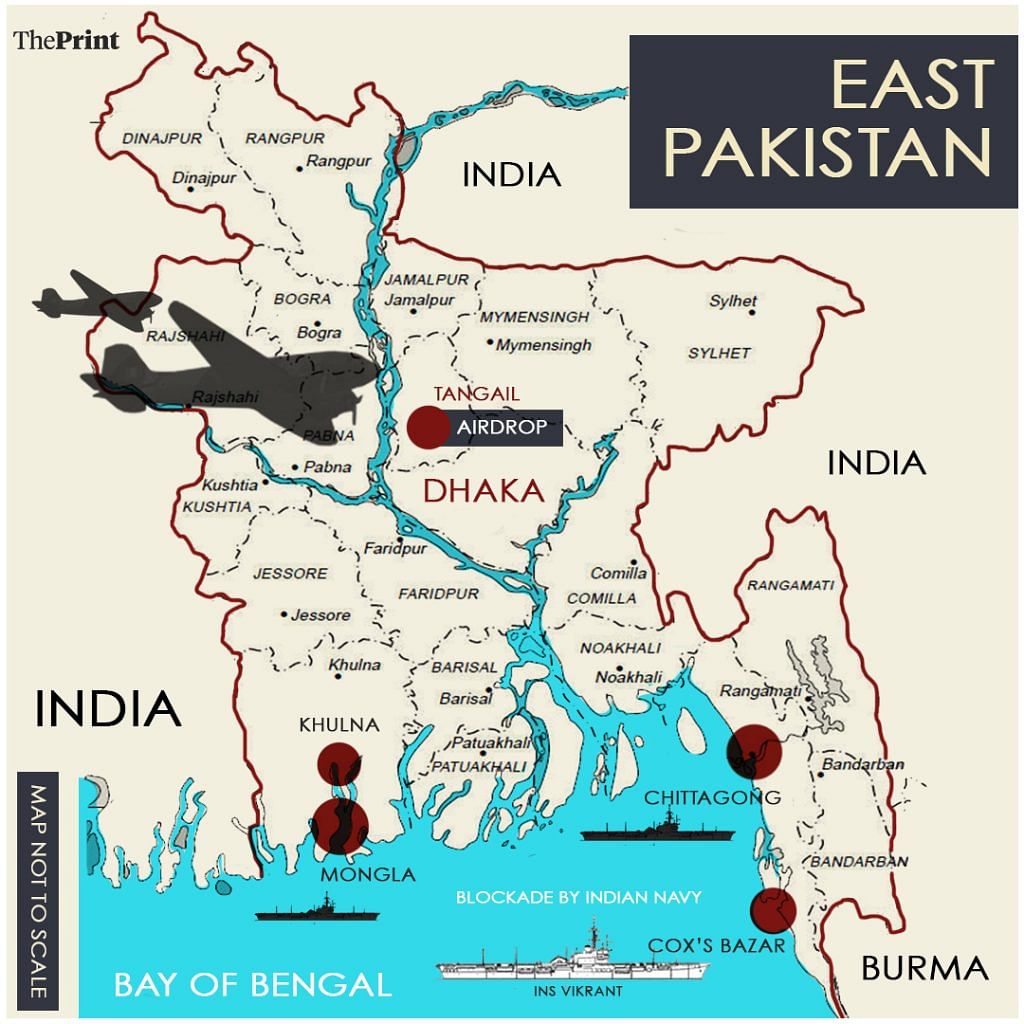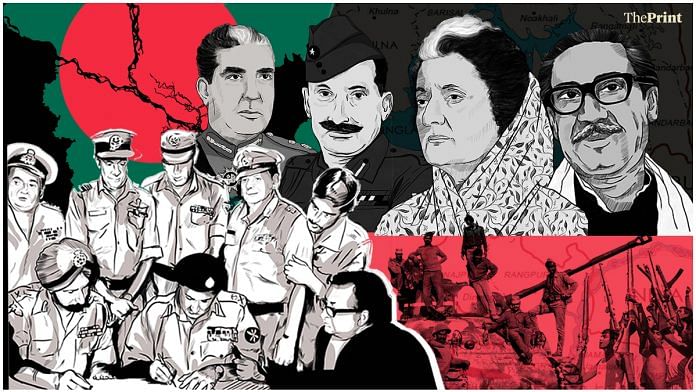PastForward is a deep research offering from ThePrint on issues from India’s modern history that continue to guide the present and determine the future. As William Faulkner famously said, “The past is never dead. It’s not even past.” Indians are now hungrier and curiouser to know what brought us to key issues of the day.
For now, this is available immediately to all ThePrint readers. Very soon PastForward will be among the premium offerings that go behind a paywall, only available to subscribers.
New Delhi: It was 50 years ago today that India pulled off the biggest and most decisive military win it has achieved.
On 16 December 1971, nearly 93,000 Pakistani military and government officials, led by Lt Gen. A.A.K. Niazi, commander of East Pakistan, surrendered before the Indian Army, ending the war that began on 3 December. This was the largest surrender by an army since World War II, and led to the division of Pakistan and the creation of a new country, Bangladesh.
Now, 50 years later, as India aims for the theaterisation of its military, the 1971 Bangladesh Liberation War is considered as the finest example of cohesive war fighting. It is the only war that saw all three wings of the Indian defence — the Army, Navy and Air Force — fighting together in multiple theatres.
The war saw the political class, the Army, Air Force, Navy, intelligence agencies as well as paramilitary forces come together to pull off a victory that caught the world by surprise.
It is the only war that India fought with heavy fighting in both the eastern and western sectors. In fact, three of the four Param Vir Chakras (the highest wartime gallantry award) awarded for the 1971 war went to Flying Officer Nirmal Jit Singh Sekhon, Major Hoshiar Singh and Second Lieutenant Arun Khetarpal, who fought in the western sector.
The fourth went to Lance Naik Albert Ekka for his gallant actions on the eastern front.
Also Read: 5 heroes of 1971 Bangladesh Liberation War who led India to decisive win over Pakistan
The latest controversy
A number of books have been written about the 1971 war, looking at various aspects, including the personalities involved.
However, a recent book, ‘India and the Bangladesh Liberation War: The Definitive Story’, written by Chandrashekhar Dasgupta, a diplomat who has been India’s former ambassador to China and the European Union, has come under scrutiny.
The book — released in November — seeks to contradict Field Marshal Sam Hormusji Framji Jamshedji Manekshaw’s claim that he had persuaded then-prime minister Indira Gandhi to delay the war.
According to then-Army chief Manekshaw, Gandhi wanted the Army to launch an immediate offensive into East Pakistan to counter the trail of atrocities launched by Lt Gen. Tikka Khan, also known as the ‘Butcher of Bangladesh’.
Manekshaw had himself recounted what had happened on the afternoon of 29 April 1971, when Gandhi had called an urgent cabinet meeting.
Besides Manekshaw, who was a special invitee, those present were then-defence minister Jagjivan Ram, external affairs minister Sardar Swaran Singh, agriculture minister Fakhruddin Ali Ahmed and finance minister Y.B. Chauhan.
“What are you doing?” Manekshaw recounted a fuming Gandhi asking him, while throwing reports of refugee influx from East Pakistan sent by then-West Bengal chief minister Siddartha Shankar Ray on the table.
“I want you to walk into East Pakistan,” she said, to which he responded, “That means war.”
“I don’t mind if it is war,” the prime minister then said.
Recounting the meeting during the launch of ‘Liberation and Beyond: Indo-Bangladesh relations’, a book written by former foreign secretary J.N. Dixit, Manekshaw recounted himself saying, “I have only 30 tanks and two armoured divisions with me. The Himalayan passes will be opening anytime. What if the Chinese give an ultimatum? The rains will start now in East Pakistan. When it rains there, the rivers become oceans. I guarantee 100 per cent defeat.”
According to him, Gandhi adjourned the meeting to 1600 hours (4 pm), but held him back. “Shall I send in my resignation, on grounds of health, mental or physical?” Manekshaw asked, but Gandhi gave the Army chief the time he wanted to elaborate on his strategy.
However, in his book, Chandrashekhar Dasgupta writes that while she was under pressure from some of her cabinet colleagues to intervene in the war in April 1971, Gandhi had already made up her mind to wait for several months.
He quotes her principal adviser at the time, P.N. Haksar, as saying, “We cannot, at the present stage, contemplate armed intervention at all… it would evoke hostile reactions from all over the world and all the sympathy and support which the Bangladesh (cause) has been able to evoke in the world will be drowned in (an) Indo-Pak conflict.”
As Carnegie India director Rudra Chaudhuri noted in his article for ThePrint, Dasgupta, in his book, said that Manekshaw, “a gifted raconteur”, had “circulated a colourful tale about how he had restrained Mrs Gandhi from ordering the Indian Army to march into East Pakistan in April”.
However, he also noted that Gandhi’s biographers, such as Pupul Jayakar, had corroborated Manekshaw’s version of events.
Speaking to ThePrint, Air Vice Marshal Arjun Subramaniam (retd), a military historian, expressed surprise about what he called “attempts to undermine” the legacy of Field Marshal Manekshaw and the military advice that eventually led to the creation of Bangladesh.
He said no book or articles written by any military writer had tried to take away due credit from the prime minister’s office or Indira Gandhi, who was the prime minister and the decision-maker.
However, Subramaniam admitted that the Army has not been able to institutionally set the record straight, since no recorded minutes of these important discussions have come out so far.
“The 1971 war was an all-government approach. This means that the political leadership of that time, along with the military leaders, were part of the process,” he added.
Also Read: Govt and military owe India an authentic history of the 1971 Bangladesh War. Rest is mythology
The origin of the war
While the 1971 war officially began on 3 December that year, the origin of the war actually dates back at least two decades, if not more.
While the immediate cause of resentment in then East Pakistan were the elections called by dictator Gen. Yahya Khan, the seeds were sown in February 1948, when the Pakistani government declared Urdu as the official national language. This decision irked the Bengali-speaking East Pakistan, and the people revolted.
The first protest against this decision broke out at Dhaka University on 11 March 1948, when Sheikh Mujibur Rahman, a university student at the time, was a key participant. The police had opened fire, sparking off a chain of events which eventually led to the creation of Bangladesh.

Adding fuel to the fire was Pakistan’s founder Mohammad Ali Jinnah, who visited Dhaka on 21 March 1948 and declared that “Urdu and Urdu alone” would be the language of the state of Pakistan.
Even as differences grew between East and West Pakistan during the tenure of Gen. Ayub Khan, who became president in a coup in 1958, the final nail in the coffin came during the tenure of Gen. Yahya Khan.
Yahya had refused to convene Parliament after the 1970 elections in which the East Pakistan-based Awami League, led by Rahman, decisively won against Zulfiqar Ali Bhutto’s Pakistan Peoples’ Party.
‘Operation Searchlight’
Anusha Nandakumar and Sandeep Saket, authors of the book ‘The War That Made R&AW’, wrote that it was in Larkana, the hometown of Zulfikar Ali Bhutto, that the plot of the genocide in East Pakistan was conceived.
According to the book, after the elections, a furious Yahya Khan and Bhutto went on a duck-shooting trip to Larkana.
“There, between the sounds of gunshots, the Larkana conspiracy was hatched. It was a cruel, comprehensive and final plan to crush the resistance in the east and dismember the region once and for all. It aimed at depriving East Pakistan of a successor government and abandoning it to anarchy, so that West Pakistan could swoop in and take over,” the book added.
In early 1971, India’s new intelligence agency — the Research and Analysis Wing (RAW) headed by legendary Indian spy Rameshwar Nath Kao, who was in 1968 a deputy director in the Intelligence Bureau when he was given charge to set up the new organisation — had started getting inputs from Pakistan and Sri Lanka that multiple commercial flights were moving into East Pakistan from the West with a fuelling stop in Colombo.
Kao suspected that soldiers from West Pakistan were being ferried into East Pakistan for a large-scale operation.
On 25 March 1971, the Pakistan Army officially launched its campaign of genocide called ‘Operation Searchlight’ under Lt Gen. Tikka Khan, unleashing death squads that reportedly slaughtered 7,000 unarmed, innocent Bengalis in a single night.
This continued for days. Once the military realised that the war was not going to end after the systematic campaign of targeting the elites, the generals and their militias changed course and began to actively target the female Bengali population through rape, noted the book ‘Genocide and Mass Violence in Asia’ edited by Frank Jacob.
“The policy was driven in the hopes of psychologically breaking the men and women of Bengali society,” it said.
As days passed, lakhs and lakhs of refugees started coming into India from East Pakistan. This turned out to be catastrophic for India, which could no longer sit idle and watch.
This was when Indira Gandhi called for the cabinet meeting on 29 April.
From April to August, Army made plans
Asked why Manekshaw sought time, Maj. Gen. Randhir Sinh (retd), who was then ADC to the legendary Lt Gen. Sagat Singh and author of ‘A Talent for War – The Military Biography of Lt Gen. Sagat Singh’, told ThePrint that plans for the operation had to be made.
Sources in the defence and security establishment said the Army was focusing on the western borders, and those with China and East Pakistan were not the focus for any full-fledged operation.
However, RAW was keeping a close watch on developments in both West and East Pakistan and briefing PM Gandhi regularly.
Sinh said it was only in August when Lt Gen. Sagat Singh received his operational instructions, and moved to Tripura in September.
He said while operational instructions were issued only in August, Army chief Manekshaw had already ordered for movement and works by the border roads personnel for making roads and bridges.
Lt Gen. Singh, who was chief of the 4 Corps, was allocated 8 and 57 Mountain Division and his reserve, 23 Mountain Division.
Incidentally, the most important thrust into East Pakistan was carried out by 4 Corps and it covered the area stretching from Sylhet in the north to Chittagong in the south. The sector was defended by two Pakistani divisions.
AVM Subramaniam (retd) said Lt Gen. Singh was the man who eventually led to the fall of Dhaka through his ingenuity of heliborne operation and his determination to take Dhaka, which was not part of the original plan.
According to the Indian Army’s own records, on the Eastern front, it defeated four divisions and 30,000 para-military forces of the Pakistan Army in the course of the war.
Three corps and the 101 Communication Zone Area of the Indian Army participated in the Eastern sector.
The 33 Corps consisting of 20 Mountain Division and 71 Mountain Brigade carried out operations in the north-western sector of East Pakistan between the Jamuna and Padma rivers.
While the Brigade advanced on the Pachagarh-Thakurgaon axis, the Division attacked the waistline of the sector, that is the Hilli area, Army records state.
The 33 Corps also captured Pakistan Army’s strongholds of Rangpur and Bogra on 16 December.
The 2 Corps carried out operations in the south-western sector of East Pakistan.
Also Read: Operation Eagle — The 1971 mission by RAW and Tibetan SFF that has no official record
The heroic battles within the war
While the war was fought, there were numerous battles that remain etched in history as some of the finest moments of bravery.
One such was the Battle of Longewala, where Kuldip Singh Chandpuri, then a Major, and his small group of just over 100 soldiers defended the Longewala border post in Rajasthan by fighting against nearly 2,000 Pakistani soldiers who had over 40 tanks. The 1997-hit film Border, based on the Battle of Longewala, showed Chandpuri’s heroic efforts in the battle.

Another battle of the 1971 war was the one fought in Basantar, which is known as the greatest tank battle fought by the Indian Army.
Two of the four prominent Param Vir Chakras — awarded to Maj Hoshiar Singh of 3 Grenadiers and Second Lt Arun Khetrapal (posthumous) — came from this battle.
An operation by the 2nd Battalion of the Parachute Regiment was also a critical factor in the war. Known as the ‘Tangail Operation’, a battalion and more were air-dropped to capture the Poongli Bridge on Jamalpur-Tangail-Dhaka road and the ferry site on Louhajang River.
While the sight of around 600 soldiers dropping from the air with parachutes itself was a sight to fear, out-of-the-box thinking by Information Officer Rammohan Rao, who later joined RAW, played a critical role in possibly ending the war earlier than expected.

Nandakumar and Saket wrote in their book ‘The War That Made R&AW’ that Rao found a photograph that showed the descent of a brigade of around 5,000 soldiers in Agra.
On 12 December, Rao, who was then handling media publicity, sent the photograph from the Agra event, along with news of the Tangail airdrop, to all leading international newspapers.
“Conveniently, he didn’t mention in the accompanying press release that it was a ‘file photo’. Only Kao was aware of what the PR officer had done,” the book notes, adding that “this had a psychological impact on the Pakistani soldiers who were already feeling the pressure”.
The Navy’s role
India’s naval offensive started on 4 December when aircraft from INS Vikrant and ships under the Eastern Fleet struck military targets in East Pakistan.
In the attack, the Cox’s Bazar airfield was damaged and six Pakistani ships were destroyed at Chittagong harbour.
The Pakistani submarine ‘Ghazi’, which was trying to home in on Vikrant, was sunk off the coast of Visakhapatnam.
Ships from the Western Fleet attacked Karachi harbour on 4-5 December and destroyed three ships, and also caused damage to oil installations at the harbour.
The Karachi harbour was attacked again on 8 December while a naval task force carried out a diversionary raid on the Makran Coast and captured a Pakistani merchant ship.
“In a sense it was a two-front war and the Navy strangulated Pakistan on both sides. We choked their sea lines of communication and cut off their escape routes, hence it ended up in their surrendering in such large numbers,” Commodore Srikant Kesnur, a naval historian and serving officer, told ThePrint.
“The war ended up with the Navy achieving not just physical destruction but also physiological dominance over Pakistan,” he added.
The man credited for the spectacular naval operations during the 1971 war was then-Navy chief Admiral S.M. Nanda. “Admiral Nanda was an outstanding leader of war. He was daring and audacious,” said Commodore Kesnur.
IAF overwhelmed Pakistan in East, contained it in West
The 1971 war was officially declared on 3 December when the Pakistan Air Force launched pre-emptive strikes against IAF bases along the western borders.
Incidentally, RAW had already alerted all concerned about Pakistan’s plan to launch air strikes and the expected day was 1 December.
The IAF carried out 4,000 sorties in the west and 1,978 sorties in the east against targets in both parts of Pakistan.
Aerial conflict between India and Pakistan had actually begun on 22 November 1971, when at about 1449 hours, four Pakistani Sabres strafed Indian and Mukti Bahini positions in the Chowgacha Mor area.
Within 10 minutes, as the Pakistani jets were in middle of a third strafing run, the Sabres were intercepted by four Gnats from No. 22 Squadron, a detachment of which was operating from Dum Dum Airport, Calcutta.
Three of the Sabres were shot down and all Gnats returned to base safely.
“There is no doubt that the IAF played a crucial role during the 1971 war. It had tipped the scales in India’s favour in the eastern sector and ensured that the Pakistani jets remained in a defensive role in the western sector. This ensured that the Pakistanis were not able to cause much damage to the Indian forces on the ground,” Jagan Pillarisetti, a military historian with keen interest in the air force, told ThePrint.
Pillarisetti, who runs www.bharat-rakshak.com, said the IAF lost more aircraft in the war than the Pakistan Air Force, but this was a given since it was on an offensive operation.
He added that the continuous air assaults impacted the morale of the Pakistan Army.
According to the Indian Air Force (IAF), on the western front, its primary tasks were disruption of enemy communications, destruction of fuel and ammunition reserves, and prevention of any ground force concentrations, so that no major offensive could be mounted against India while Indian forces were primarily engaged in the East.
On the eastern front, the IAF’s role was to provide direct support to ground forces launching multiple operations including rapid-moving infantry and armour advancing from three directions, airborne and heliborne assaults, missile bombardments from ships and an amphibious landing.
The IAF also won its first and only Param Vir Chakra in this war. Flying Officer Nirmal Jit Singh Sekhon was a pilot of a Gnat detachment based in Srinagar for the air defence of the Kashmir Valley against Pakistani attacks.
On 14 December 1971, six Pakistani Sabre fighters attacked the Srinagar airfield. As they began bombing and strafing the airfield, Sekhon, who was on duty, took off immediately, taking on the six all alone.
He secured hits on one aircraft and set another on fire. Eventually, he was shot down and killed.
(Edited by Gitanjali Das)
Also Read: What was the Chuknagar massacre? A lesser-known, bloody episode from 1971 Bangladesh war



